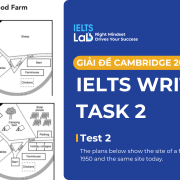Nếu còn mắc nhiều lỗi sai khi làm IELTS reading, việc dành thời gian phân tích và đọc giải thích trong các bài giải đề Cam 19 Test 3: Passage 1 – Archaeologists discover evidence of prehistoric island settlers dưới đây sẽ giúp các bạn nâng cao thần tốc kỹ năng Reading của mình trong thời gian ngắn. Đây cũng là nguồn đề sát với đề thi thật nhất trong vô số các tài liệu hiện nay
.
A. Đáp án
| Câu 1: piston |
Câu 5: quality | Câu 9: FALSE | Câu 13: NOT GIVEN |
| Câu 2: coal | Câu 6: railway(s) | Câu 10: NOT GIVEN | |
| Câu 3: workshops | Câu 7: sanitation | Câu 11: TRUE | |
| Câu 4: labour/labor | Câu 8: NOT GIVEN | Câu 12: TRUE |
B. Giải thích đáp án đề Cam IELTS 19, Test 2, Reading Passage 1
| Câu hỏi + Đáp án | Bài đọc |
|
Câu 1: Archaeological research had taken place on the island of Obi before the arrival of Ceri Shipton and his colleagues. => FALSE: Dr. Ceri và đồng nghiệp là người đầu tiên nghiên cứu -> Mâu thuẫn ở từ “Before” |
In early April 2019, Dr Ceri Shipton and his colleagues from Australian National University became the first archaeologists to explore Obi, one of many tropical islands in Indonesia’s Maluku Utara province. The research team’s discoveries suggest that the prehistoric people who lived on Obi were adept on both land and sea, hunting in the dense rainforest, foraging on the seashore, and possibly even voyaging between islands. |
| Câu 2: At the Kelo sites, the researchers found the first clam shell axes ever to be discovered in the region.
=> True: Khớp tất cả các keywords, nhất là “ The earliest axes at Kelo – Rìu đầu tiên ở Kelo” |
There they found numerous artefacts, including fragments of axes, some dating to about 14,000 years ago. The earliest axes at Kelo were made using clam shells. Axes made from clam shells from roughly the same time had also previously been found elsewhere in this region, including on the nearby island of Gebe to the northeast. |
| Câu 3: The size of Obi today is less than it was 18.000 years ago
=> True: Khớp keywords, đó là “ Was much larger – Ngày xưa lớn hơn” -> Tương đồng “ Today is less than” |
The oldest cultural layers from the Kelo site provided the team with the earliest record for human occupation on Obi, dating back around 18,000 years. At this time the climate was drier and colder than today, and the island’s dense rainforests would likely have been much less impenetrable than they are now. Sea levels were about 120 metres lower, meaning Obi was a much larger island, encompassing what is today the separate island of Bisa, as well as several other small islands nearby. |
| Câu 4: A change in the climate around 11,700 years ago had a greater impact on Obi than on the surrounding islands.
=> Not given: Bài chỉ nói “Khí hậu ấm và ẩm hơn, khiến rừng rậm hơn” -> Không xuất hiện ý so sánh “
Câu 5: The researchers believe there is a connection between warmer, wetter weather and a change in the material used to make axes. => True: Thông tin từ chỗ “It is no coincidence….increasingly dense forest – Không phải ngẫu nhiên mà
|
Roughly 11,700 years ago, as the most recent ice age ended, the climate became significantly warmer and wetter, no doubt making Obi’s jungle much thicker. According to the researchers, it is no coincidence that around this time the first axes crafted from stone rather than sea shells appear, likely in response to their heavy-duty use for clearing and modification of the increasingly dense rainforest. While stone takes about twice as long to grind into an axes compared to shel, the harder material keeps its sharp edge for longer. |
|
Câu 6: Shipton’s team were surprised to find evidence of the Obi islanders’ hunting practices. => Not given: Bài chỉ nói tới kết quả của việc tìm kiếm “ Dựa vào xương -> Nhà nghiên cứu cho rằng người ngày xưa săn 1 loài động vật nọ” -> Không xuất hiện ý “Surprised” |
Judging by the bones which the researchers unearthed in the Kelo caves, people living there mainly hunted the Rothschild’s cuscus, a possum-like creature that still lives on Obi today. |
| Câu 7: It is thought that the Kelo shelters were occupied continuously until about 1,000 years ago.
=> FALSE: Trong bài “ Không có chứng cứ nào của việc sinh sống ở khu này, mãi cho tới 1000 năm trước” / -> Mâu thuẫn với “Continuously – Liên tục” |
Whatever the reason for the departure, there is no evidence for use of the Kelo shelters after this time, until about 1,000 years ago, when they were re-occupied by people who owned pottery as well as items made out of gold and silver |
| Câu 8: Excavations of rock shelters inside……..near the village of Kelo revealed:
=> Caves: Chú ý keyword “Contain – chứa bên trong” -> Tương đồng “Inside” |
Just inland from the village of Kelo on Obi’s northern coast, Shipton and his colleagues found two caves containing prehistoric rock shelters that were suitable for excavation. |
| Câu 9: axes made out of………., dating from around 11,700 years ago
=> Stone: Dịch nghĩa “Crafted from = Made out of – được làm từ (chất liệu)” |
Roughly 11,700 years ago, as the most recent ice age ended, the climate became significantly warmer and wetter, no doubt making Obi’s jungle much thicker. According to the researchers, it is no coincidence that around this time the first axes crafted from stone rather than sea shells appear, likely in response to their heavy-duty use for clearing and modification of the increasingly dense rainforest |
| Câu 10: …….. of an animal, evidence of what ancient islanders ate
=> Bones: Chú ý keywords “A possum-like creature = An animal”, “ People living there hunted (săn) = |
Judging by the bones which the researchers unearthed in the Kelo caves, people living there mainly hunted the Rothschild’s cuscus, a possum-like creature that still lives on Obi today. As the forest grew more dense, people probably used axes to clear patches of forest and make hunting easier. |
| Câu 11: …….which resembled ones found on other islands.
=> Beads: Chú ý keywords “Similar to = Resemble: Giống với” |
Shipton’s team’s excavation of the shelters at the Kelo site unearthed a volcanic glass substance called obsidian, which must have been brought over from another island, as there is no known source on Obi. It also revealed particular types of beads, similar to those previously found on islands in southern Wallacea. These finds again support the idea that Obi islanders routinely traveled to other islands. |
| Câu 12: had…….. as well as items made out of metal
=> Pottery (Đồ gốm): Chú ý keywords “As well as”, “Gold and silver= Metal” |
Whatever the reason for the departure, there is no evidence for use of the Kelo shelters after this time, until about 1,000 years ago, when they were re-occupied by people who owned pottery as well as items made out of gold and silver. |
| Câu 13: probably took part in the production and sale of…….
=> Spices (Gia vị): Chú ý keywords “Trade in = Sale of ( Buôn bán)” |
It seems likely, in view of Obi’s location, that this final phase of occupation also saw the Kelo shelters used by people involved in the historic trade in spices between the Maluku islands and the rest of the world. |
Trên đây là toàn bộ đáp án và những phân tích của đội ngũ học thuật của IELTS Lab cho phần giải đề Cam 19, Test 3, Reading Passage 1: Archaeologists discover evidence of prehistoric island settlers. Chúc các bạn học tốt!
>> Tham khảo thêm: https://www.youtube.com/watch?v=hT4uSyRrUE4
>> Đọc thêm: https://ieltslab.edu.vn/cach-lam-dang-bai-matching-infomation-trong-ielts-reading/


















Trả lời